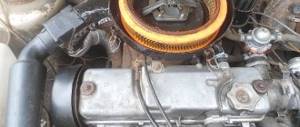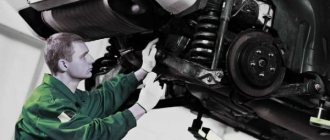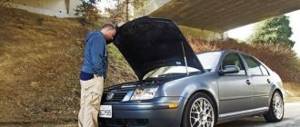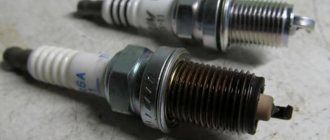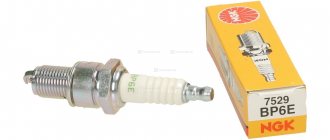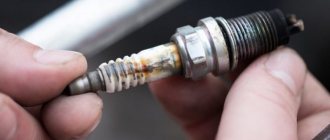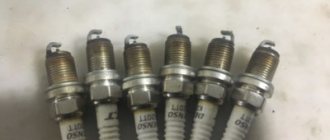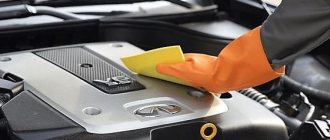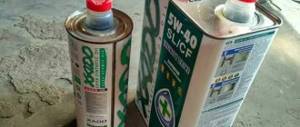Signs of tripling
A motor is a complex technical device that requires constant monitoring by the driver. Without maintenance for a long time, or if the car is operated around the clock, but maintenance is rarely carried out, changes occur in the operation of the engine, which include: noises, knocks, squeaks; power reduction; increased fuel consumption; increased asynchronous vibration; and engine tripping. There are several signs that cause the engine to start to stall:
- Rough engine operation (asynchronous vibration). That is, the motor vibrates randomly, sometimes frequent, sometimes infrequent twitching. This happens when the combustible mixture in one of the cylinders does not ignite.
- One spark plug is not working. This happens when carbon deposits or soot appear on the candle, if the candles are flooded. The problem can be solved by stripping the spark plug, heating it over a fire, burning off the carbon deposits, and checking the gap.
- The car “shoots”, that is, popping sounds are heard from the muffler. This means that there are gaps in the combustion of the combustible mixture in the working chamber of the cylinder, then the ignition is triggered and a bang occurs. This happens with carburetor engines when it was running on choke, which is why overshoot occurred.
- The car accelerates slowly or even stalls if you give the gas sharply. Signs of slow acceleration may also indicate the presence of another problem in the engine.
- Excessive fuel consumption. If one cylinder does not work or fires rarely, then the fuel supplied there simply comes out unburned from the muffler.
- The needle on the tachometer is jumping. On modern cars, a certain corresponding icon may light up on the instrument panel.
- The car jerks while driving.
Manifestation of malfunction
First, you need to make sure whether your problem really fits the definition of “engine trouble.” To better understand the cause of the occurrence, you need to understand the very essence of the malfunction, and at the same time decide whether your dilemma is similar to the one described below.
We recommend: Is it possible to eliminate the hum in the power steering on your own?
So, what happens to the car and what changes in engine performance can occur? To begin with, as we said earlier, the engine life will noticeably decrease. This is especially noticeable in cars with manual transmission (we'll talk more about this below). In addition, the most likely thing is that the car will begin to shake and vibrate while driving. Vehicle acceleration deteriorates sharply, operating speeds decrease, and the level of fuel consumed increases by almost several liters.
Cylinders are the most important indicators of normal engine operation
Causes of engine tripping
When the engine starts to rev, you can immediately hear changes in its operation. Out-of-sync motor twitching, staggering in discord. This happens that the frequency, the cycle of work is disrupted.
Here are the reasons there may be if the engine starts to stall:
- The ignition timing is incorrectly set.
- There is an air leak in the vacuum brake booster system.
- The spark plug has failed. This is the most common reason, since spark plugs are usually changed until the old ones stop working. Although it is recommended to change it every 20 thousand kilometers of passage.
- The high-voltage wire is broken. These are the wires that go onto the spark plugs.
- The capacitor has failed.
- The tightness of the intake manifold system is broken.
- A valve or piston has burned out, so compression is not created.
- The piston ring is burnt out. Due to this reason, a lot of smoke comes out of the muffler.
- The valves in the gas distribution system are not configured correctly.
- The rockers, that is, the camshaft journals, are worn out.
- The cylinder head gasket is broken.
- The valve stem seals are worn out, that is, they have hardened, pierced, or crumbled.
- If the engine is carburetor, then it often happens that the carburetor is not configured correctly, which causes the supply of fuel and air to be disrupted.
- Worn distributor shaft or turntable shaft bearing.
- The air filter is clogged and does not allow the required amount of air to pass through.
- The diaphragm of the vacuum ignition timing regulator has broken.
- Fresh sparks are not suitable for this engine.
Some of the above reasons are typical only for carburetor engines, for example, cars of the VAZ family.
One of the important rules for keeping the engine in working condition is timely periodic checking of the oil level. Check the oil level with a dipstick with two or three marks marked on it.
Car engine trouble: causes and solutions
Almost every resident of the country has his own car. It not only allows you to enjoy driving, but also makes everyday life easier.
But soon all sorts of problems and breakdowns may arise that cannot be avoided. If your engine stalls, then this is the worst thing.
Many beginners are very afraid of such a negative consequence. Let's figure out what tripling the power unit means.
Description of the breakdown
The concept itself arose several decades ago. It was mainly applied to four-cylinder engines when one of the cylinders fails. During such a misfortune, one could hear a characteristic sound and feel a slight vibration of parts.
In addition, the compression itself decreases, which is very bad. It is worth noting that not only gasoline, but also diesel engines are subject to tripping.
If the problem is not detected in time, you will have to make major repairs or buy a new power unit. Both will require a huge amount of money and time.
Main signs of failure
If you know the main symptoms of the problem, it will be much easier to understand why the engine is shaking.
There are a few of them:
- There is a malfunction in the operation of the power unit, the idle speed jumps, and you can also feel vibration throughout the vehicle interior. This kind of manifestation clearly indicates the failure of one of the cylinders. The main problem is that such symptoms appear quite late, when one of the “culprits” has already failed;
- The electrode became covered with a large amount of soot and turned black. In this case, inexperienced drivers simply change the spark plug and that’s it. They don't even think about the possible causes of the problem. If your electrode turns black, this indicates a very serious problem with the power unit. To the point where the engine stalls;
- The exhaust sound has changed a lot. As a result, the car may shake slightly. An experienced driver will immediately understand what’s going on;
- Fuel consumption increases several times. This phenomenon can occur due to numerous problems. In this case, you should contact a car service and carry out a full diagnosis;
- The dynamics of the vehicle deteriorate slightly. As a rule, this is noticeable during acceleration and at low speeds. This symptom indicates not only that the engine is malfunctioning, but also other malfunctions. In this case, you need to undergo a full diagnosis;
- The engine speed begins to fluctuate, which is very noticeable on the tachometer. In some cases, fluctuations can vary between 900 and 1500 rpm. These are very serious implications;
- While driving, all sorts of jerks occur. This is noticeable when accelerating and in working gear.
Causes of failure
Now we come to the most interesting part. Now we will find out why the engine stalls and what needs to be done. If you are faced with such a problem, then you cannot hesitate and remain inactive. This attitude will only worsen the overall condition of the engine.
The consequences are manifested not only in unpleasant sensations from the trip, but also in excessive wear of parts. The second problem is more significant and frightening. After all, if an important component fails, then that’s it, you will have to make major repairs and change the engine.
Experts identify several main reasons:
- The ignition is set incorrectly;
- Problems in the vacuum booster;
- Problems with spark plugs;
- Problems in the wires;
- Problems in the piston rings;
- The distributor is faulty;
- Incorrect valve adjustment and burnout;
- Air filter problems.
Next, we will talk in more detail about each cause and methods for eliminating them.
Troubleshooting
The first thing you should look at is the candles. As a rule, they become the main cause of power unit malfunctions. You should unscrew the spark plug and check for carbon deposits and soot.
Defects can cause current leakage in the insulator. It is also necessary to check the insulator itself. There should be no light stripes or other marks on it. Lastly, you can look at the gap between the electrodes.
Replacing spark plugs is not very difficult. To do this you need to do the following operations:
- Clean the engine compartment from debris and other unnecessary things;
- Remove the engine components to gain good access to the spark plug. If you can’t remove the elements, you can use a simple extension cord and adapter. Experts do not recommend removing spark plugs after the engine has warmed up. That is, you need to leave the car alone and let it cool to room temperature;
- You need to unscrew one by one, gradually disconnecting the wires. For your own safety, you should remove the battery from the vehicle. The fact is that even when the engine is idling, a small charge of electricity can be supplied. You should always remember this when it comes to car repairs. Experts note that you need to apply your strength very carefully. After all, if the candle does not feed, then the thread can be broken. This fact can be attributed to one of the reasons for investing additional funds;
- All openings should be covered with a rag to prevent debris and other objects from getting in;
- You need to screw in the candles very carefully, at the initial stage using your hands. This approach will allow you to avoid knocking down the thread and apply the correct force. After screwing in, you can connect high-voltage wires;
- Flush the engine and check its performance.
If after replacing the spark plug the engine still runs unstable, then move on to other reasons.
Next come the high-voltage wires, which play an important role. They must be inspected for breakdowns and other defects.
If black dots or stripes are detected, this indicates a spark breakdown. Simply put, the power of the spark does not reach the electrode of the spark plug, as a result of which the engine stalls when cold.
To determine the condition of the wires, do the following:
- Remove the tip that attaches to the spark plug;
- Check the structure of the high-voltage wire. It consists of a central core and a tip, which is attached to the spark plug. It is worth noting that the type of tip may vary slightly depending on the make and model of the vehicle. Its main purpose is to transmit current to the spark plug;
- The core should not move away from the tip. As a result of aging, the surface may oxidize and become poorly conductive. As a result, the wire resistance increases and motor tripping occurs. The presence of oxidation can be checked very easily. To do this, take the multimeter probe and touch the central core. If the device shows nothing, then the surface is oxidized;
- Also, the core can burn out along its entire length. To identify the damaged area, you need to use a special multimeter tip, which looks like a thin needle. It is necessary to pierce the wire every 5-10 millimeters until the damaged area is identified. When a high-quality area is found, the device will show the required resistance indicator. As soon as the burnt area is discovered, you need to take a knife and cut off part of the wire. This method allows you to restore stable operation of the power unit. If the wire is not very long, then you just need to change it.
Cold diesel troits
The reasons for diesel engine tripping differ from gasoline engines. Such an engine fails either because the required compression of the fuel mixture is not created, or because the correct fuel supply or its quality is impaired.
Reasons for diesel tripping:
- Airing.
- The glow plugs are faulty.
- The injector is jammed.
- Incorrect valve clearances.
- The timing belt (gas distribution mechanism) and fuel injection pump are not aligned correctly.
Read more about why diesel troits.
Diesel stalls due to a problem with the fuel system
In order for the engine to start working, the fuel must travel from the gas tank to the engine cylinder, passing through the high pressure fuel pump (HPF) and being sprayed through the injectors. Each of these stages can create its own problems.
Components of the engine fuel system
We recommend: DIY methods for removing bumper scratches
A common cause of diesel engine throttling is airing of the system; this phenomenon occurs when air gets inside the fuel system. As a result, one of the cylinders does not receive the fuel-air mixture (or receives it with insufficient fuel) and performs its power stroke differently than the others. The reason may be a malfunction of the high pressure fuel pump (HPF), or a leak in the fuel system as a whole.
Why does the engine injector troit?
The reasons listed above are also typical for injection engines, except for points: 13 and 14. To the reasons for the injector, you can also add the failure of the ignition module or the injector itself is faulty, the injectors are clogged, the injector wires are broken. An experienced motor mechanic is needed to diagnose and repair the injector and injectors.
Before contacting a car service, you should try to fix it yourself. This is possible in many cases, because there are many small reasons that are easy to eliminate on your own. You should start by checking the spark plugs and high-voltage wires. It is not difficult to check the functionality of the spark plugs; you need to start the engine, put on rubber gloves (if the wire is broken, to avoid electric shock), and one by one disconnect the wire from the spark plug. If the cylinder is working as expected, then when the wire is disconnected, the sound of the motor will change and the engine will begin to shake (change vibration). If the cylinder is not working, then disconnecting the wire will not make any changes in the operation of the motor. Therefore, it is necessary to change or clean the spark plug.
Loss of diesel engine compression
At times, a diesel engine stalls when cold, just like a gasoline internal combustion engine, due to loss of compression. Here, as it heats up, the work stabilizes, because the compaction in the cylinders increases according to the law of physics. That is, they expand when heated, and everything returns to normal. This situation occurs if the parts of the CPG or valve mechanism are not worn to a CRITICAL level.
Loss of compression can be caused by sticking (sticking) of the cylinder rings due to poor quality fuel or oil. It's very simple to check - with the engine running, pull out the dipstick to check the oil level and if exhaust gases come from under it, then the rings are most likely stuck. It is better not to delay with this problem, since with stuck rings there is a very high probability of scoring on the cylinder liners, which will result in expensive repairs.
We recommend: Car diagnostics and repair
Why does a carburetor engine troit?
Dealing with the tripping of a carburetor engine is much easier. In general, such engines are simple due to the lack of computerized systems.
All of the above reasons in the paragraph “reasons for engine tripping” are typical for engines with a carburetor.
Here, accordingly, there can be no problems with the injector or ignition module. The most common reason for cars with such engines is that the spark plug does not work, then the wire from the distributor to the spark plug is broken, then the carburetor is incorrectly configured, then the valve burns out, then the piston burns out or the piston rings fail.
0
Author of the publication
offline 1 day
Engine “troits”: causes of failure and methods for eliminating it
One of the most common engine malfunctions is interruptions in the operation of one or more of its cylinders, which among motorists is referred to as “troubling the engine.”
Anyone who has encountered this phenomenon is probably familiar with its symptoms. But not all car enthusiasts know what the causes and consequences of such a breakdown are.
Today we will tell you in detail why the engine misfires, how to diagnose and properly repair the engine.
Reasons why the engine “troubles”
The engine may throb constantly or from time to time. General signs of engine vibration are as follows: at idle speed, strong uneven vibrations begin to penetrate from the engine compartment into the cabin, the sound of the running engine changes (it “growls”, goes from high “notes” to low ones, and back).
The unit begins to consume more fuel, and its power decreases, and obscene sounds are heard from the exhaust pipe, accompanied by thick white or black smoke. If at least one of these signs is present, it means that the “heart” of your car has problems with one or more cylinders.
If they are not eliminated in time, the consequences can be very disastrous - up to and including a major overhaul of the power unit.
internal combustion engine
Let's characterize the most common reasons why an engine stalls - there are four of them:
- late or early ignition of the air-fuel mixture (FA);
- uneven entry of fuel into the engine cylinder;
- lack or excess of air in the combustion chamber of the cylinder;
- drop in compression level.
Let's take a closer look at them.
Reason #1
. If the air-fuel mixture ignites in the cylinder earlier or later than the specified period, then the spark plugs are to blame, which produce too weak a spark, or the formation of a spark occurs untimely. Weak sparking occurs due to the fact that harmful deposits (carbon deposits) accumulate on the spark plug body and its electrodes, which interfere with spark breakdown.
carbon deposits on candles
Another reason for a weak spark is the destruction of its insulator. In the place where the insulator has collapsed, a soot spot forms, which prevents the formation of a normal spark.
If there is no spark at all, then there may be several reasons: a worn spark plug cap, a failed high-voltage wire (supplies current to the spark plug), a breakdown of the ignition coils or switch.
The latter phenomenon is quite rare, but it would not be superfluous to check the condition of the switch, which controls the ignition distribution.
Reason #2
. Uneven entry of fuel into the cylinder, when a smaller amount of gasoline or diesel is poured into the combustion chamber, often occurs due to a malfunction of the fuel pump parts (pressure part or pressure reducing valve) or the pressure valve in the fuel supply system.
If more fuel than necessary gets into the cylinder, the problem probably lies in the fuel injectors - they are dirty or out of order.
Finally, another “fuel” reason for engine throttling is a malfunction of the electronic control unit (ECU) of the power unit, which can erroneously increase or decrease the supply of gasoline/diesel to the cylinder.
Reason #3
. Excess air in the cylinder is a sign of depressurization of the air supply system, which includes the air filter, intake pipe hose, throttle pipe and receiver. A lack of this important component of the air-fuel mixture in the cylinder can be caused by a dirty air filter or broken throttle valves.
air filter clogged
A malfunction of the mass air flow sensor or throttle position sensor, which the ECU perceives as a request from the engine to add or reduce the amount of air into the combustion chamber, can also cause the engine to trip.
Reason #4
. Low compression or its complete absence is perhaps the most serious reason why an engine misfires. This is the first sign that the pistons or valve in an idle cylinder are burnt out, or the piston rings are completely worn out.
This cannot be done without serious repairs to the power unit. In addition to the common reasons why an engine misfires, there are also secondary ones. They are spoken of when the engine starts to run periodically - “cold” (at idle speed) or “hot” (at medium or high speed).
The most common malfunction here is the valves: when their gap increases at idle speed, the engine trips, which goes away as it warms up (the gap is restored).
And vice versa, the gap increases when the engine reaches operating temperatures - that’s when it starts “hot” with all the signs described above.
Diagnostic methods
If all the signs that the engine is malfunctioning are present, it is necessary to diagnose it and determine which cylinder has failed and for what reason.
You can carry out the check yourself, or you can take the car to a service station, where its power unit will be subjected to detailed computer diagnostics.
In most cases, you can determine the reason for the engine tripping yourself, but if the cylinder refuses to work, for example, due to low compression, it is better to seek help from an experienced mechanic.
Step 1.
Determine the problem cylinder. We check the operation of the cylinders with the engine running, so all safety measures must be observed. We turn on the ignition, open the hood, listen to the engine. We remember what sound it works with. We begin to disconnect the high-voltage wires going to the spark plugs one by one.
Disconnect high-voltage wires
When the working cylinder is turned off, the engine begins to rev with double force. If you disconnect the spark plug on the non-working cylinder, the behavior of the engine will not change.
Another way is to not touch the high-voltage wires, but one by one turn off the chips that control the supply of fuel from the injectors to the cylinders.
If one of the chips is turned off, the operation of the engine will not change - this is how we detect a malfunctioning cylinder.
Step 2.
We check the condition of the high-voltage wire and spark plug. We disconnect the high-voltage wire and carefully inspect it. If we notice damage to the insulating layer, it means that the cause of the malfunction is in the wire.
It would also be useful to check the integrity of the current-carrying core - if it is broken or burnt out, then a breakdown or internal resistance occurs (we measure it with a multimeter, check it with normal readings), which interferes with the normal supply of current to the spark plug.
But if the wire is intact, then the problem is in the spark plug. You need to unscrew it and inspect it carefully.
unscrew the spark plug
If you find visible damage to the spark plug base or its electrodes (carbon deposits), it will have to be replaced. If the spark plug is intact, we look for the problem that is causing the engine to continue to stall.
Step 3.
We measure whether enough air enters the cylinder. The lack of air enriches the fuel assembly, which leads to engine tripping. We check the tightness of the air supply system: close the inlet pipe, use a compressor to supply air into the cylinder at a pressure of 0.5-0.7 atm through a vacuum hose, and listen.
If a characteristic hissing sound is heard, it means that the air supply system has become depressurized. Another diagnostic method is to check the air filter. If it is clogged, little air enters the cylinder.
We diagnose the throttle sensor and the mass air supply sensor - for this you will need a laptop, which we connect to the diagnostic connector.
Step 4
. We determine how much fuel enters the cylinder. To do this, we measure the pressure in the fuel system with a pressure gauge (up to 7 atm), which we attach to the injector ramp.
The pressure must be measured in 4 stages: when the ignition is turned on, at idle speed, at operating speed with the tube removed from the fuel pressure regulator and with the check valve tube pinched. If it is low, then the elements of the fuel pump or pressure valve in the fuel supply system have probably failed.
If it’s normal, check the condition of the injectors; they may become dirty or even fail. Finally, we check the operation of the fuel system using diagnostic equipment - errors in the ECU are possible.
Step 5.
We measure the compression in the cylinder using a compression gauge, which we insert into the spark plug hole of the problem cylinder, turn on the ignition and increase the engine speed. We take readings several times. If compression drops by 15%, then the piston, valves or piston rings in the cylinder are worn out. To determine this failure, you will have to disassemble the engine.
